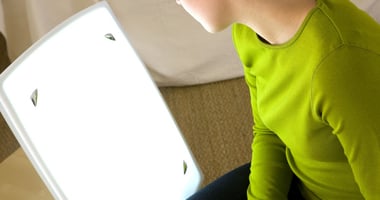Six weeks of cognitive-behavioral therapy sessions tailored for seasonal affective disorder...
Bright Light Therapy Found To Be Effective in Treating Adults With MDD
 |
To examine the efficacy of light treatment alone or in combination with antidepressants for the treatment of MDD, Raymond Lam, M.D., a professor of psychiatry at the University of British Columbia, and colleagues conducted an eight-week randomized, placebo-controlled trial of adults aged 19 to 60.
A total of 122 patients with MDD were randomly assigned to one of four groups: light therapy (active white light box for 30 minutes in early morning plus placebo pill each day); antidepressant therapy (inactive negative ion generator plus fluoxetine hydrochloride (20 mg) each day; combination light and antidepressant treatment; or placebo (inactive negative ion generator plus placebo pill). The primary outcome measure was a reduction in score on the Montgomery Åsberg Depression Rating Scale (MADRS), from baseline to endpoint. Secondary outcome measures included response (greater than 50% reduction in MADRS score) and remission (MADRS score less than 10 at end point).
The results showed that light monotherapy and combined therapy was statistically superior to placebo as it relates to reduction in MADRS scores; there was no statistical difference between fluoxetine monotherapy and placebo. For the respective placebo, fluoxetine, light, and combination groups at the end point, response was achieved by 33.3%, 29.0%, 50.0%, and 75.9% and remission was achieved by 30.0%, 19.4%, 43.8%, and 58.6%.
“Bright light treatment, both as monotherapy and in combination with fluoxetine, was efficacious and well tolerated in the treatment of adults with nonseasonal MDD. The combination treatment had the most consistent effects,” noted the researchers. “Further studies exploring mediators and moderators of response will be important.”
To read more about therapies for seasonal affective disorder, see the AJP in Advance article “Outcomes One and Two Winters Following Cognitive-BehavioralTherapy or Light Therapy for Seasonal Affective Disorder.”
(Image Point Fr/Shutterstock)
SAMHSA Seeks Chief Medical Officer to Address MH Issues at Federal Level
Here’s a rare opportunity to maximize the reach of your medical knowledge and skills by becoming a part of a federal agency that seeks to improve the mental health of all Americans. The Substance Abuse and Mental Health Services Administration (SAMHSA) is recruiting for the position of chief medical officer in its Office of Policy, Planning, and Innovation in Rockville, Md. Among the positon’s major responsibilities are advising SAMHSA’s Advisory Committee on a range of medical and scientific policy questions, providing expert advice on medical considerations and related matters that impact on program plans and/or goals, and participating in national meetings and symposia involving experts and leaders in behavioral health. Click here for more details and application information.





